#writing writer create creative
Text
How to create an atmosphere: Supermarket
Sight
advertisements for products
big signs showing discounts
aisles full of colorful products
fresh produce
employees in matching uniforms
all different kinds of costumers
with shopping carts
with children running around
with a stroller or toddlers sitting in the shopping cart
with a service dog by their side
Hearing
the sound of shopping carts being pushed and bumping into shelves
parents calling for their children
people talking on the phone
a man asking his wife if they still have enough toilet paper at home
someone asking the employee where they can find something
music interrupted by announcements about promotions the store is doing
the surring and beeping sound of the cash register belt
the sound of the electronic doors opening and shutting again
Touch
the stickiness of the floors
the differents textures of each item they think about buying
the coldness and often stickiness of the handle of the shopping cart
the sudden wetness from some products that are either fresh produce or where the package is leaking
Smell
the smell of spilled drinks that someone dropped and left for the employees to clean up
the smell of cleaning products from them having to sweep it up
the smell of hand sanitizer
the smell of different products the costumer holds up to their face and smells to decide if they like it
the horrendous smell of deposit machines where you return your not quite empty beer bottles to and the leftover liquid spills everywhere
Taste
different samples offered at the supermarket
If you like my blog and want to support me, you can buy me a coffee or become a member! And check out my Instagram! 🥰
#writeblr#how to create an atmosphere#supermarket#writing ideas#creative writing#writers on tumblr#writing exercise
3K notes
·
View notes
Text
5 Tips for Creating Intimidating Antagonists
Antagonists, whether people, the world, an object, or something else are integral to giving your story stakes and enough conflict to challenge your character enough to change them. Today I’m just going to focus on people antagonists because they are the easiest to do this with!
1. Your antagonist is still a character
While sure, antagonists exist in the story to combat your MC and make their lives and quest difficult, they are still characters in the story—they are still people in the world.
Antagonists lacking in this humanity may land flat or uninteresting, and it’s more likely they’ll fall into trope territory.
You should treat your antagonists like any other character. They should have goals, objectives, flaws, backstories, etc. (check out my character creation stuff here). They may even go through their own character arc, even if that doesn’t necessarily lead them to the ‘good’ side.
Really effective antagonists are human enough for us to see ourselves in them—in another universe, we could even be them.
2. They’re… antagonistic
There’s two types of antagonist. Type A and Type B. Type A antagonist’s have a goal that is opposite the MC’s. Type B’s goal is the same as the MC’s, but their objectives contradict each other.
For example, in Type A, your MC wants to win the contest, your antagonist wants them to lose.
In Type B, your MC wants to win the contest, and your antagonist wants to win the same contest. They can’t both win, so the way they get to their goal goes against each other.
A is where you get your Draco Malfoy’s, other school bullies, or President Snow’s (they don’t necessarily want what the MC does, they just don’t want them to have it.)
B is where you get the other Hunger Games contestants, or any adventure movie where the villain wants the secret treasure that the MCs are also hunting down. They want the same thing.
3. They have well-formed motivations
While we as the writers know that your antagonist was conceptualized to get in the way of the MC, they don’t know that. To them, they exist separate from the MC, and have their own reasons for doing what they do.
In Type A antagonists, whatever the MC wants would be bad for them in some way—so they can’t let them have it. For example, your MC wants to destroy Amazon, Jeff Bezos wants them not to do that. Why not? He wants to continue making money. To him, the MC getting what they want would take away something he has.
Other motivations could be: MC’s success would take away an opportunity they want, lose them power or fame or money or love, it could reveal something harmful about them—harming their reputation. It could even, in some cases, cause them physical harm.
This doesn’t necessarily have to be true, but the antagonist has to believe it’s true. Such as, if MC wins the competition, my wife will leave me for them. Maybe she absolutely wouldn’t, but your antagonist isn’t going to take that chance anyway.
In Type B antagonists, they want the same thing as the MC. In this case, their motivations could be literally anything. They want to win the competition to have enough money to save their family farm, or to prove to their family that they can succeed at something, or to bring them fame so that they won’t die a ‘nobody’.
They have a motivation separate from the MC, but that pesky protagonist keeps getting in their way.
4. They have power over the MC
Antagonists that aren’t able to combat the MC very well aren’t very interesting. Their job is to set the MC back, so they should be able to impact their journey and lives. They need some sort of advantage, privilege, or power over the MC.
President Snow has armies and the force of his system to squash Katniss. She’s able to survive through political tension and her own army of rebels, but he looms an incredibly formidable foe.
Your antagonist may be more wealthy, powerful, influential, intelligent, or skilled. They may have more people on their side. They are superior in some way to the protagonist.
5. And sometimes they win
Leading from the last point, your antagonists need wins. They need to get their way sometimes, which means your protagonist has to lose. You can do a bit of a trade off that allows your protagonist to lose enough to make a formidable foe out of their antagonist, but still allows them some progress using Fortunately, Unfortunately.
It goes like… Fortunately, MC gets accepted into the competition. Unfortunately, the antagonist convinces the rest of the competitors to hate them. Fortunately, they make one friend. Unfortunately, their first entry into the competition gets sabotaged. Fortunately, they make it through the first round anyway, etc. etc.
An antagonist that doesn’t do any antagonizing isn’t very interesting, and is completely pointless in their purpose to heighten stakes and create conflict for your protagonist to overcome. We’ll probably be talking about antagonists more soon!
Anything I missed?
#writing#creative writing#writers#screenwriting#writing inspiration#writing community#filmmaking#books#film#writing advice#antagonists#villains#writing antagonists#5 tips for creating intimidating antagonists
2K notes
·
View notes
Text
The 5 Most Essential Turning Points in a Character’s Arc
You spend so much time creating a character because you want them to feel real. You want to connect with them and use them to create an experience for your readers. Their character arc is how that happens.
Don’t miss out on these essential turning points that make an arc feel not only whole, but complete.
1. The Inciting Incident
Your inciting incident gets your plot moving. It isn’t going to be the first sentence of your story (also called your hook), although it could be if you crafted your first sentence for that purpose.
An inciting incident is a plot event that guides your character in a new direction. It’s the successful prison break, the meeting of instant rivals, or the moment your protagonist wins the lottery in your first chapter.
Without the inciting incident, your protagonist’s life would carry on as usual. They wouldn’t start the arc that makes them an interesting person for the reader to stick with throughout your story.
2. Introducing the Protagonist’s Main Flaw
Every protagonist needs a primary flaw. Ideally, they’ll have more than one. People aren’t perfect and they rarely get close enough to only have one negative characteristic. Protagonists need that same level of humanity for readers to connect with them.
There are many potential flaws you could consider, but the primarily flaw must be the foundation for your character’s arc. It might even be the catalyst for the story’s peak.
Imagine a hero archetype. They’re great and well-intended, but they have a problem with boasting. Their arc features scenes where they learn to overcome their need to brag about themselves, but they get drunk and boast in a bar right before the story’s peak. The antagonist’s best friend hears this because they’re at the same bar, so they report the hero’s comment to the main villain. It thwarts the hero’s efforts and makes the climax more dramatic.
Other potential flaws to consider:
Arrogance
Pride
Fear
Anxiety
Carelessness
Dishonesty
Immaturity
3. Their First Failure
Everyone will fail at a goal eventually. Your protagonist should too. Their first failure could be big or small, but it helps define them. They either choose to continue pursuing that goal, they change their goal, or their worldview shatters.
Readers like watching a protagonist reshape their identity when they lose sight of what they wnat. They also like watching characters double down and pursue something harder. Failure is a necessary catalyst for making this happen during a character’s arc.
4. Their Rock Bottom
Most stories have a protagonist that hits their rock bottom. It could be when their antagonist defeats them or lose what matters most. There are numerous ways to write a rock-bottom moment. Yours will depend on what your character wants and what your story’s theme is.
If you forget to include a rock-bottom moment, the reader might feel like the protagonist never faced any real stakes. They had nothing to lose so their arc feels less realistic.
Rock bottoms don’t always mean earth-shattering consequences either. It might be the moment when your protagonist feels hopeless while taking an exam or recognizes that they just don’t know what to do. Either way, they’ll come to grips with losing something (hope, direction, or otherwise) and the reader will connect with that.
5. What the Protagonist Accepts
Protagonists have to accept the end of their arc. They return home from their hero’s journey to live in a life they accept as better than before. They find peace with their new fate due to their new community they found or skills they aquired.
Your protagonist may also accept a call to action. They return home from their journey only to find out that their antagonist inspired a new villain and the protagonist has to find the strength to overcome a new adversary. This typically leads into a second installment or sequel.
Accepting the end of their arc helps close the story for the reader. A protagonist who decides their arc wasn’t worth it makes the reader disgruntled with the story overall. There has to be a resolution, which means accepting whatever the protagonist’s life ended up as—or the next goal/challenge they’ll chase.
-----
Hopefully these points make character arcs feel more manageable for you. Defining each point might feel like naming your instincts, but it makes character creation and plotting easier.
Want more creative writing tips and tricks? I have plenty of other fun stuff on my website, including posts like Traits Every Protagonist Needs and Tips for Writing Subplots.
#character arcs#creating characters#creating character arcs#character development#writing characters#character concept#plotting#how to plot#writing plot#creative writing#writeblr#writers of tumblr#writing tips#writing advice#writing resources#writing inspiration#writing community#writing help#writing
1K notes
·
View notes
Text
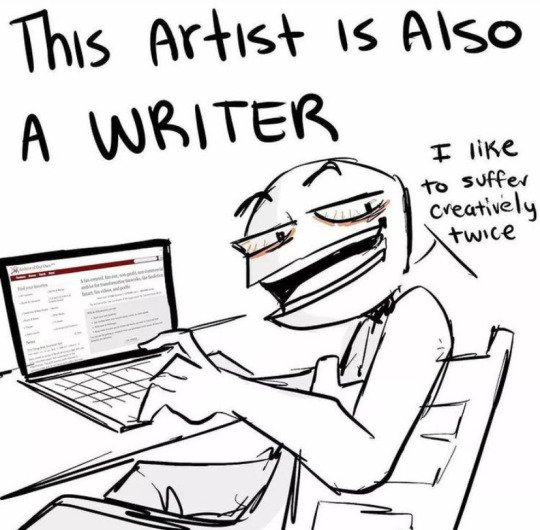
actually me fr
#art#artist#artwork#writers#writing#writer community#writers on tumblr#artists on tumblr#creative writing#create#multimedia#banana talks#memes#funny meme#lol memes#funny#funny pics#funny shit#ha ha funny#funny stuff#funny meme haha#funny memes#funny meme xd#funny content#meme
228 notes
·
View notes
Text
Quick tip from the art/lit world
Drop the need to impress and shock people with themes or bad words and porn. Not only because of how deeply desensitized our society is: drama, horror, gore, sex, drugs & rock'n'roll and similar genres or other tragic, violent themes do not hold any inherent value, not on their own.
The reason a director from Czechoslovakia will talk about the horror of war using pigeons on a mushroom trip and it's going to be exceptional is because it makes sense to him first. I can use all the same elements he did and my work will be shit. There is always reason and context for creation. Reason and context. Why and how you make what you make.
The worst thing you can do as an artist or writer is try to impress others. It will show. Mature people can spot that miles away. Drop the hard themes you know nothing about. Stop listening to the internet 13-year-old kids who never leave their rooms trying to help you (or charge you to help) you write about such a complex and stigmatized theme as drug abuse, for example.
Go inwards for wisdom. Go to your own heart chambers, be quiet and listen. It will tell you what you need to write about. Be honest, raw and wild. But first, try to understand what those words really mean in the current context.
With all my love, Iva.
#i dont usually give advice but this particular theme was burning inside my mind for weeks now#writers on tumblr#writers and poets#writeblr#ivatalks#this is not exactly advice tho is more of a perspective on creative work and how we sometimes ought to go after more knowledge about#the craft itself and the process of creating because that can open your eyes for the fact that you have precious things inside you#you dont need to give your money to a coach you need to focus on yourself#your life and experience and what you need to say about that#and the more i think about it and write about this I know I'm always speaking to myself first#writing advice#writing tips#how to write#creative writing#fiction#original fiction#original fantasy#writing community#tumblr writing community#tumblr writers#tumblr writing society#writing help#writing resources#art#creative minds#be free
38 notes
·
View notes
Text

#creating#creative inspiration#creative writing#content creator#artists on tumblr#art#digital art#artwork#writer memes#writers meme#writer#writeblr#painting
90 notes
·
View notes
Text
You ever scrolling through tumbler and you see everyones beautiful au’s of these beloved jesters and think
Damn am I lucky to exist in this world at this time
#yalls beautiful creativity is overwhelming at times#nothing makes me happier to wake up in the morning and see what your brilliant minds have come up with today#first thing I see in the morning last thing I think about when I go to bed#never stop creating#artists never stop drawing#writers never stop writing#never stop doing what you love#even when the day comes where you move past the fandom we are all still rooting for you#and just as excited to see what you come up with next!#we see you#we only wish we could put to words how much your creations have become a deep rooted part of our lives#and you inspire us to put as much love into our work as you have in yours
134 notes
·
View notes
Text



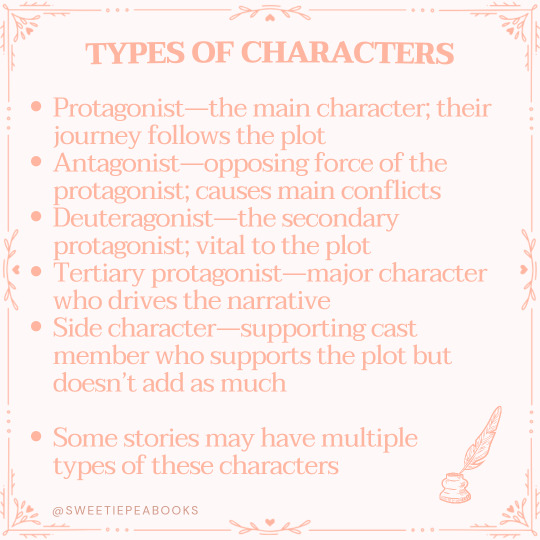
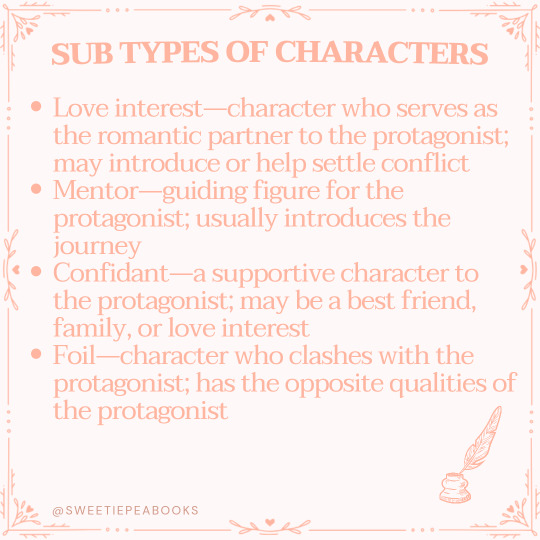


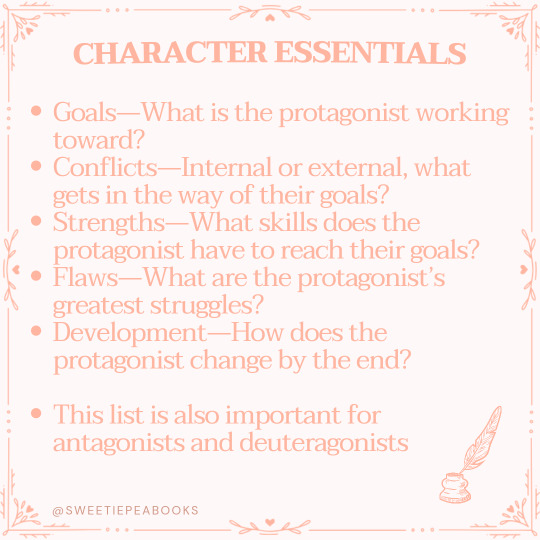
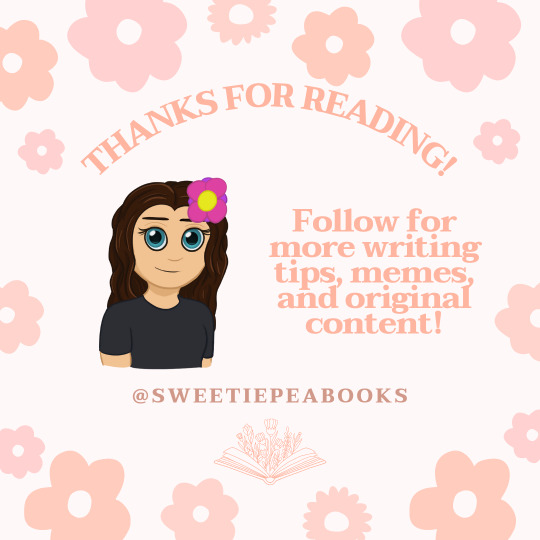
A simple beginner's guide to creating characters ✨️
#writers on tumblr#writing community#writer stuff#writing tips#creative writing#original character#creating characters#writing wip#beginner writer#writing advice
32 notes
·
View notes
Text
to change
"to change," - a piece on grief and life after loss. I died that day, too. I will never be the same and neither will the world. But thank you; thank you for your pride and love. Thank you for giving me something to mourn and celebrate. Spring is of no great importance, but the rain is sweet and the sun is soft, as if nature too, has weathered after you left.





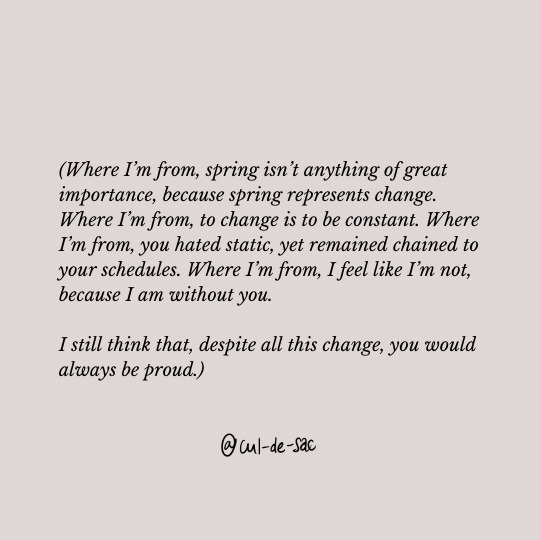
(crossposted on @/vrs.culdesac on Instagram and on Medium.)
#my writing#writeblr#vhas creates#mixed media#spotify#prose#desi writers#creative writing#grief#dealing with grief#loss#moving forward#Spotify
21 notes
·
View notes
Text
Happy mothers day to all the writers out there, whether you have spawned or not.
Don't forget you've created life too!
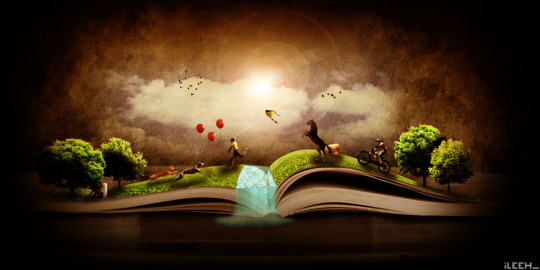
The lives you create will never die so long as there are people to read.
#mothers day#mother's day#writers#creating life#it's hard work#I don't know who the artist is#please tag them if anyone knows#books#writers and poets#writeblr#writer#writing#writers on tumblr#creation#stories#creative writing
21 notes
·
View notes
Text
I WANT to WRITE but when I SIT on WORD there is NOTHING in mY BRAIN
#writing#creative writing#fanfiction#fanfic#writeblr#writers#writers on tumblr#writer#writerscommunity#send help#I want to write angst so bad but it's like the need to write angst overtakes the actual act of writing angst creating MORE ANGST-
27 notes
·
View notes
Text
Writing Foundations: Creating Paragraphs
You can have the best story in the world, but if it’s all in one chunk on the page, you may struggle to find people willing to read it. To break it up, you need to know where and when to create new paragraphs.
Every new paragraph starts with an indent. So, to create a new paragraph, hit the enter key, and then the tab key, which is typically on the left side of the Q and either says TAB or looks like two stacked arrows pointing in separate directions.
So when do you start a new paragraph?
1. Anytime a new character speaks
The most obvious place to break up your paragraph is when a new character is speaking. Take this example.
“Hi John,” said Mary as she walked into the room. John was reading a book, and tucked a bookmark between the pages as she sat next to him. “how was work?” “It was good,” she replied, “but my boss really didn’t like the draft I sent her.” “That’s too bad, I thought it was some of your better work.”
Vs.
“Hi John,” said Mary as she walked into the room. John was reading a book, and tucked a bookmark between the pages as she sat next to him.
“How was work?” He asked.
“It was good,” she replied, “but my boss really didn’t like the draft I sent her.”
“That’s too bad, I thought it was some of your better work.”
See the difference? So you make a new line whenever a new character is speaking. In the case of Mary speaking twice, “It was good…” “but my boss…” we keep that in the same paragraph. Whereas when John speaks after Mary, it becomes its own paragraph.
The only time you may split the same character speaking is if they have a large chunk of dialogue. In that case, you can split their dialogue according to the next rule.
2. Any new idea
This isn’t necessarily a hard rule like the last one is. We have a lot of room to make interesting creative decisions when breaking up description or action. For the most part, though, you’ll want to break up your paragraph whenever there’s a new thought or idea. So:
A thin plastic film coated the room, making the furniture gleam in the sunlight streaming through the windows. On her right sat a couch upholstered in ivy coloured fabric, untouched by time.
Anna swept her fingers through her hair, chewing on her lip. She watched Rick out of the corner of her eye, “What are you thinking?”
The detective’s expression was completely neutral, though he clutched his pen tightly in one fist. In his other hand was a notebook, three questions written across it in blocky text,
1. Why are all the clocks stopped at 5:32?
2. Where’s the murder weapon?
3. Why did my wife leave me?
“Same as the others,” he said, tapping his pen against the last question, “the plastic wrap killer.”
So in this example we go from describing the room, to describing an action Anna is doing, to describing the detective, and then his notes. These are all separate ideas, so we can split them into their own paragraphs.
As well, as long as it’s about the same character or within the same ‘idea’, description can be paired with dialogue. You can see Anna’s dialogue comes after the description of her. You can totally do this, or you can split it into its own paragraph if you’d like. It looks natural where it is because Anna is the subject of the paragraph, and she’s also the one speaking.
In the case of the detective speaking, his action comes between dialogue. Also allowed, since the detective is the subject of that paragraph.
3. Any new location or skip in time
Similar to the last, if the scene starts outside, when they move inside it’s a new paragraph. If they go into a new room, get into a car, etc. Any time they change location, it starts a new paragraph. Same for a skip in time. If you need to go from day to night, new paragraph.
Kayde looked anxiously up at the looming oak doors. The windows were dark, layered in years of dust and grime. It’s now or never, they thought.
They pushed through the doors and into the foyer.
Kayde seemed to wait there for hours, and by the time someone came to greet them, it was already dark outside.
4. For style/effect
This is one of my favourite parts of writing. Once you nail when you should be splitting your paragraphs, you can start to play with splitting them for effect. I do this quite a lot. Take this example:
She fixed an ugly stare at herself in the mirror, long locks of brown hair hanging in front of her eyes. A pair of sharp scissors gleamed at the edge of the glass, pinched between her fingers. Dania raised the scissors to her hair.
Snip.
A lock fell towards the sink, the edges rough and imperfect.
Snip.
Another.
She chopped and hacked away at her hair until it was clumped in an unsightly pile over the drain of the sink, her head round and covered in patches where she didn’t quite get close enough to her skin.
She was finally free.
While the cutting of her hair could be in the same paragraph, it gives it more drama and effect when it’s split. Any time a character is going through something shocking or emotional, maybe try playing around with the paragraph to see if you can add some additional drama to it.
Paragraphs can be as long or short as you’d like them to be, as long as you have intention behind it!
#writing#creative writing#writers#screenwriting#writing community#writing inspiration#filmmaking#books#film#writing advice#writing foundations#writing foundations: creating paragraphs#formatting paragraphs#paragraphs
561 notes
·
View notes
Text
Tips for Starting and Stopping Chapters, Plus FAQs
Even if you have the most exciting, engaging ideas for your novel, you might struggle to write it because you have to deal with chapters. These are a few of the most frequently asked questions about chapters and a few tips that might help you overcome manuscript challenges.
How Many Chapters Should a Book Have?
Unfortunately, there’s no straightforward answer to this question. Genres and intended audiences influence manuscript word counts. Younger readers will need shorter chapters to keep their interest and older readers might prefer longer chapters that dive deep into conflict or theme.
Storytelling elements also change the number of chapters per book. A fast-paced novel might have more short chapters to keep up the faster narrative pace. A slower novel might linger in wordier scenes, so there could be fewer chapters with longer page counts per chapter.
You can always look at comparable novels in the same genre to guestimate how many your manuscript could include. If you’re writing a Twilight-inspired novel in the same fantasy genre and Twilight has 26 chapters in a ~110,000 word count range, you could aim for a similar number.
What’s the Purpose of Chapters?
Chapters divide longer stories into segments that help readers process new plot events. They give people breathing room to digest heavier topics or moments by pausing or putting the book down to do other things for a while.
They also give more weight to cliffhanger moments or events made to shock readers. Even if they immediately flip the page to keep reading, the momentary pause lends gravity and meaning to whatever ends the chapter before.
Tips for First Chapters
Include Some Action
The first line of every chapter doesn’t need to be a dramatic car chase scene, but the chapter in its entirety should include some plot-moving action. It hooks readers and gets your pacing started.
Add Emotional Weight
Action can only intrigue readers so much. What’s the emotional weight compelling your protagonist to take part in, react to, or fight back against your inciting incident? Establish some emotional weight in the first chapter to motivate your protagonist, like showing how much they love their sister before getting betrayed by her in the inciting incident.
Avoid Infodumping
Readers don’t need to know everything about your world-building or protagonist in the first chapter. The infodumping only weighs down your pace. Sprinkle your descriptions and reveals throughout the first act of your book to keep readers coming back to learn more about the world.
Tips for Starting a Chapter
Introduce a Choice
Choices help stories move along at a pace that keeps readers engaged. If your protagonist is stuck in their head for most of a chapter, there’s nothing pushing your story forward. Always include at least one choice when starting a chapter, whether it’s big or small.
Keep Expanding Your Conflict
Every chapter should expand your primary conflict in some way. It might affect newly introduced characters, change your protagonist’s world, or require a sacrifice. As long as your conflict is relevant to your chapter in some way, your story will always remain true to its thematic purpose.
Remember Your Cause-and-Effect
An initial chapter sets up or introduces a conflict that gets your plot moving. If you’re unsure what to do in the following chapter, use it to address the effects of that previous chapter’s conflict. Although the conflict likely won’t get resolved that quickly, you can still write about your characters’ choices post-conflict or how the world changes in a way that affects their futures.
Tips for Ending a Chapter
Experiment With Your Endings
I used to be afraid of ending a chapter without some shocking, groundbreaking plot twist. Althought that’s a great place to put those moments, it’s not plausible to end every chapter with one. Where would your readers feel comfortable pausing for the night? When would they feel the quiet sanctity of peaceful moments where characters build trust between themselves?
Play around with your endings by refusing to be afraid to cut your manuscript into segments. If one doesn’t feel right during your read-through, you can always merge it into the next chapter and cut them differently during editing.
Use It to Shift Your Story
When your story needs to change times of day, locations, or perspectives, that’s usually a good sign that you need a page or chapter break. It’s not always necessary, but these are the types of chapter breaks that give readers breathing room.
Again, you can always re-work your chapters during editing if you find that they aren’t ending in the right places during your first few read-throughs.
Ramp Up Your Tension
Who says chapters always have to end on a cliffhanger? You can also end them when the action or tension is becoming more intense. When two characters are in the car on the way to rob a bank, they argue over whether or not to actually shoot people. One character’s eagerness and the other’s disgust raises the tension. As it escalates into them yelling in the parking lot, the chapter can end when one leaves the car and slams the door.
Ending on a moment of heightened tension is another reason readers turn pages and stay engaged. In the above case, they might not be able to put the book down until they find out if the robbery resulted in murder.
-----
Starting and stopping chapters can cause plenty of anxiety, but remember—you’re always in control of your manuscript. Play around with these ideas and make any necessary changes in your editing phases. You’ll figure out the best way to organize your story by chapters and develop more confidence in your long-form storytelling abilities.
#creating chapters#writing chapters#chapter length#writing a first chapter#writeblr#writing advice#writing tips#writers of tumblr#writing#writing help#creative writing#writing inspiration#writing community#writing a novel#writing a book#writing a story
609 notes
·
View notes
Text
“Writing is writing what you cannot know before you have written: it is preknowing and not knowing, blindly, with words. It occurs at the point where blindness and light meet.”
— Hélène Cixous, from Three Steps on the Ladder of Writing (tr. by Susan Sellers) (Columbia University Press, April 15, 1994) (via Alive on All Channels)
24 notes
·
View notes
Text
Been working my ass off on a double length update for the premier of A Place Among the Stars, my original sci-fi... debut? I guess? In that it's my debut into sci-fi. Guys I've worked so hard on it hhhhh I hope people like it. There will be some teaser art coming out soon-ish.
It'll be releasing April 28th thru Patreon.
In May, I'll also be releasing a free ebook that contains the first few chapters from each of my stories, to allow you to sample Khajit's wares (is that joke too dated). Once it drops, please feel free to download it and also send it to every single group chat you're in that has a book recommendation channel lmao. Remember: you can't beat free!
#adventures of a fic writer#this is my equivalent of the 99c sales that authors do just to get eyes LOL#anyway yes please love a place among the stars it has been a labor of extended love#it's my first time writing a sci-fi novel and also my first time creating a brand new universe from scratch by myself#there's so much tradition you can lean on in fantasy or real world settings#sci fi is a lot more creative honestly... i've read so much in preparation for this AND THEY ARE ALL VERY DIFFERENT!!#which is fun because you can get away with just about fucking anything#but daunting because you have to explain a lot more#did I fall back on my old faithful “multiple perspectives”? yes absolutely
30 notes
·
View notes
Text
In case anyone is unsure how to get their writeblr dash more active...
People get busy. Life happens, and we can’t always be super active on our blogs in the ways we want to be (this is where I am currently). These are some things I like to do after I feel like I’ve been away from my blog for a while that also help the community and other writeblrs out. ♡
♡ Look through the latest writeblr introduction/active writeblrs/looking for active writeblrs/creative writing/etc. tags and make it a priority to r e b l o g everyone's intros and latest wips and such. This helps introduce yourself to others as well as helping everyone else out in the community by giving active blogs more attention and interaction.
♡ Follow and interact with the people you see in the tags! We are the lifeblood that keeps this community alive and without us the writeblr community wouldn’t exist on Tumblr. Use that to your advantage!
♡ Write a writeblr reintroduction! Let people know you’re still alive and kicking and looking to be more involved in the community. Make posts that reintroduce your WIPs, characters, and more.
♡ Don’t be afraid to message writers and ask them about their WIPs and characters, as well as asking for others to look over your WIPs and see what they think of them. I can’t speak for others but my inbox is always open and I love chatting with other writers and hyping each other up! It’s the best.
♡ Participate in writeblr tag games and get to know the fellow writers in your community and what kind of genres they like to write in, what their writing styles are like, how often they like to write, what their favorite tropes are, etc.
♡ Reblog. Reblog. REBLOG. It’s great to receive a like on your writeblr posts but reblogging is what keeps our community thriving and helps others get more eyes on their work. It’s a great way for writers to support other writers, and really, that’s what the community is for. :)
Feel free to pm me or add more if you’ve got any tips. :)
#writeblr#writeblr community#active writeblrs#creative writing#looking for active writeblrs#writelr intro#writeblr introduction#active writers#writers on tumblr#writblr tag games#writing activites#tumblr writers#creating writing blogs#active writing blogs#writing tips#writing blogs#writing advice#writeblr wips#worldbuilding#writing wips#pass it along y'all
542 notes
·
View notes